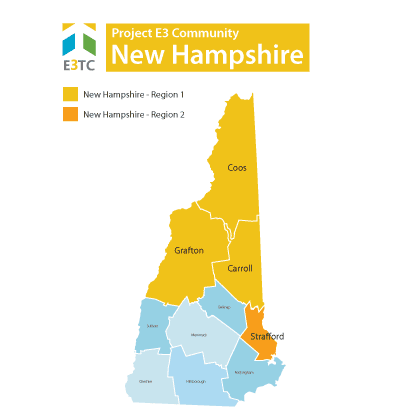New Hampshire was chosen as a targeted community through the Vocational Rehabilitation Technical Assistance Center: Targeted Communities (VR-TAC-TC) or Project E3. Project E3 partnered with State VR Agencies and local community partners to improve outreach and employment-related services to underserved people with disabilities in this community.

New Hampshire has the highest percentage of timberland area in the country. It has some of the largest ski mountains on the East Coast so skiing, snowmobiling, and other winter sports are major tourist attractions. The fall foliage and summer cottages along many lakes and the sea are also very popular attractions. Tourism is an important part of the state’s economy.
New Hampshire is a primarily rural state, encompassing a total of 10 counties, seven of which are rural and characterized by higher poverty relative to the urban areas. The geographic isolation of New Hampshire’s rural communities poses significant challenges for persons with disabilities in achieving competitive, integrated, and lasting employment, as well as full community participation and integration.
Targeted Communities
The state-federal vocational rehabilitation system in New Hampshire faced many challenges as it strove to serve people with significant disabilities and promote competitive integrated employment. Project E3 provided intensive technical assistance to two regions of the state:

Key Information:
Wage
No State Minimum Wage
This makes it more difficult to prepare consumers for: personal finance management, job readiness, and transition to integrated employment.
INCOME
Lowest in New Hampshire: Coos, Carroll, and Grafton Counties
4th lowest in New Hampshire: Stratford County
Rural Population
National average = 6.3%
Poverty Rate
People without disabilities = 6.1%
Students In Special Education
National average = 8.7%
Low income students are disproportionately represented in the special education population.
Targeted Populations
Within the targeted communities, Project E3 focused on improving vocational rehabilitation service outcomes for these populations:
These populations were characterized as:
Primary Challenges for Targeted Populations
The combination of the challenges above and other factors created significant barriers for persons with disabilities living in New Hampshire, including:
Key Strategies to Address Barriers
Following are some of the key strategies developed and implemented to address the targeted populations' challenges and barriers to employment.
Community-Based Participatory Research (CBPR): To understand a community’s issues and concerns, one needs data and information both supplied by common data sources and interpreted by the community to better understand their issues and possible solutions to those issues. CBPR’s methodology is predicated on deep and extensive community involvement in the identification of issues and concerns and in the resolution of those issues and concerns.
Community Outreach and Orientation: Vocational Rehabilitation held a series of meetings with organizations serving youth to ascertain roles, confidence in their abilities to work collaboratively across schools and agencies going forward, and confidence in ability to help the young people they serve. This would be the basis for future training and collaborative arrangements
Financial Literacy Training: Vocational Rehabilitation and their community-based partners identified financial literacy as a priority strategy and used the “Your Money, Your Goals (PowerPoint)” curriculum to train staff.
New Hampshire Overview PowerPoint Presentation
Project Outcomes
Project E3 provided New Hampshire’s state Vocational Rehabilitation agencies and their partners with the skills and competencies needed to effectively and efficiently address barriers to competitive integrated employment and community integration encountered by persons with disabilities in these regions.
Our specific goals for this project were to:
We will leverage promising practices, knowledge, and experience gained from this project to expand employment opportunities for individuals with disabilities from underserved and economically disadvantaged populations throughout New Hampshire and across the United States.
Project Tools and Resources
- New Hampshire Financial Literacy Training: “Your Money, Your Goals (PowerPoint)”
More Information
For further information about the New Hampshire community activities contact:

Kyle Walker, MRC, CRC, CPM
Executive Director
Stout Vocational Rehabilitation Institute (SVRI)
walkerky@uwstout.edu


